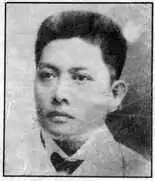Santiago Álvarez (general)
Santiago Virata Álvarez (Spanish: [sanˈtjaɣo ˈalβaɾes] : July 25, 1872 – October 30, 1930) was a revolutionary general and a founder and honorary president of the first directorate of the Nacionalista Party. Also known as Kidlat ng Apoy (En: Lightning of Fire; Fiery Lightning) because of his inflamed bravery and dedication as commander of Cavite's famous battles (particularly that in Dalahican), he was celebrated in present-day Cavite City as the Hero of the Battle of Dalahican.
Santiago Virata Álvarez | |
|---|---|
 General Santiago Alvarez | |
| Birth name | Santiago Álvarez y Virata |
| Nickname(s) | Spanish: Fuego / Tagalog: Apoy |
| Born | July 25, 1872 Imus, Cavite, Captaincy General of the Philippines |
| Died | October 30, 1930 (aged 58) San Pablo, Laguna, Philippine Islands |
| Allegiance | |
| Service/ | |
| Years of service | 1896 |
| Rank | |
| Battles/wars | Philippine Revolution
Philippine–American War |
| Relations | Mariano Álvarez (Father) Pascual Alvarez (Uncle) |
Early life
A native of Imus, Cavite, Santiago was the only child of revolutionary general Mariano Alvarez (1818–1924) and Nicolasa Virata. After his birth, his family immediately moved to Noveleta, Cavite where he acquired his early education at age seven under Sr. Antonio Dacon. He was later transferred to another private school located in the present Cavite City where he was taught by Don Ignacio Vilocillo. Since his parents wanted him to become a teacher, he was sent to Manila and enrolled at a school situated along Camba street in Tondo, Manila and was headed by Don Macario Hernández. However, his academic endeavors were interrupted by the revolution in 1896. After the revolution, he enrolled at the University of Santo Tomas but later transferred to the Colegio de San Juan de Letran where he obtained a Bachelor of Arts. He then took up law at the Liceo de Manila.
Personal life
Santiago married Pat Granados of Tanza, Cavite with whom he had ten children - Marta, Magdalena, Gabriel, Pacita, Numeriano, Egmidio, Rosendo, Virginia, Amalia, and Fidel.
Philippine Revolution
Prior to the outbreak of the revolution, Santiago was already a delegado general of the provincial council of the Katipunan in Cavite. He became captain general and later, commander-in-chief, of the Magdiwang forces and valiantly fought the Spaniards from 1896 to 1897. With his father, Mariano Álvarez, and cousin, General Pascual Álvarez, they liberated Noveleta from the Spaniards on August 31, 1896. A notable combatant, Santiago displayed heroism and bravery in various battles within Noveleta, specifically in the towns of Naic, Maragondon, Magallanes, Tanza, Alfonso, Silang, Imus, and Francisco de Malabon. From November 9 to 11, 1896, Alvarez won a decisive victory against General Ramon Blanco at the 36-hour Battle of Dalahican, one of the bloodiest battles at the advent of the Philippine Revolution.
And although marginalized within the ranks of the revolution with the ascendancy of a rival faction, Alvarez continued to support the cause of the revolution - a true testament to the character of this Caviteño.
American occupation
During the establishment of the American civil government in the Philippines in 1901, Alvarez assisted in the organization of the Nacionalista Party, wherein he later became president of its directorate. In 1902, Gov.
Death
On October 30, 1930, at age 58, he died of paralysis in Manila City and was buried at the North cemetery.
In popular culture
- Portrayed by Mario Capalad in the 2012 film, El Presidente.
- Portrayed by Allen Edzfar in the 2013 TV series, Katipunan.
Written Works
References
- "Santiago V. Alvarez: Hero of the Battle of Dalahican" (pdf). Retrieved 2012-02-18.
- "Santiago V. Alvarez". Retrieved 2012-02-18.